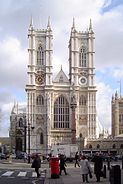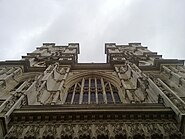| Westminster Palace, Westminster Abbey and Saint Margaret's Church* | |
|---|---|
| UNESCO World Heritage Site | |
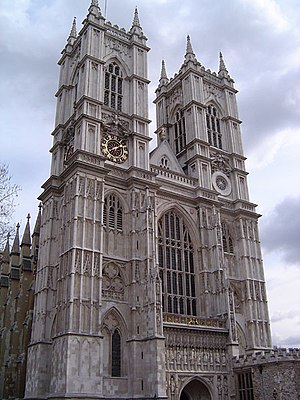
| |
| State Party | |
| Type | Cultural |
| Criteria | I, II, IV |
| Reference | 426 |
| Region** | Europe and North America |
| Inscription history | |
| Inscription | 1987 (11th Session) |
| * Name as inscribed on World Heritage List. ** Region as classified by UNESCO. | |
The Collegiate Church of St Peter at Westminster, which is almost always referred to popularly and informally as Westminster Abbey, is a large, mainly Gothic church, in Westminster, London, just to the west of the Palace of Westminster. It is the traditional place of coronation and burial site for English, later British and later still (and currently) monarchs of the Commonwealth Realms. It briefly held the status of a cathedral from 1546–1556, and is a Royal Peculiar.
Westminster Abbey is governed by the Dean and Chapter of Westminster, as established by Royal Charter of Queen Elizabeth I in 1560, which created it as the Collegiate Church of St Peter Westminster and a Royal Peculiar under the personal jurisdiction of the Sovereign. The members of the Chapter are the Dean and four residentiary Canons, assisted by the Receiver General and Chapter Clerk. One of the Canons is also Rector of St Margaret's Church Westminster Abbey (who also holds the post of Chaplain to the Speaker of the House of Commons). In addition to the Dean and Canons there are at present two full-time minor canons, one precentor the other succentor. The office of Priest Vicar was created in the 1970s for those who assist the minor canons. Together with the Clergy and Receiver General and Chapter Clerk various Lay Officers constitute the College, including the Organist and Master of the Choristers, the Registrar, the Auditor, the Legal Secretary, the Surveyor of the Fabric, the Head Master of the Choir School, the Keeper of the Muniments and the Clerk of the Works, as well as twelve Lay Vicars and ten of the choristers and the High Steward and High Bailiff. There are also forty Queen's Scholars who are pupils at Westminster School (the School has its own Governing Body). Those most directly concerned with liturgical and ceremonial matters are the two Minor Canons and the Organist and Master of the Choristers.
History[]
According to a tradition first reported by Sulcard in about 1080, the Abbey was first founded in the time of Mellitus (d. 624), Bishop of London, on the present site, then known as Thorn Ey (Thorn Island); based on a late "tradition" that a fisherman called "Aldrich" on the River Thames saw a vision of Saint Peter near the site. This seems to be quoted to justify the gifts of salmon from Thames fishermen that the Abbey received in later years. The proven origins are that in the 960s or early 970s, Saint Dunstan, assisted by King Edgar, installed a community of Benedictine monks here. A stone abbey was built around 1045–1050 by Edward the Confessor as part of his palace there: it was consecrated on December 28, 1065,[1] only a week before the Confessor's death and subsequent funeral and burial. It was the site of the last coronation prior to the Norman conquest of England, that of his successor Harold II. It was later rebuilt by Henry III from 1245, who had selected the site for his burial.

A layout plan dated 1894.
The only extant depiction of the original abbey, in the Romanesque style that is called Norman in England, together with the adjacent Palace of Westminster, is in the Bayeux Tapestry. Increased endowments supported a community increased from a dozen monks in Dunstan's original foundation, to about eighty monks.[2]
The abbot and learned monks, in close proximity to the royal Palace of Westminster, the seat of government from the later twelfth century, became a powerful force in the centuries after the Norman Conquest: the abbot often was employed on royal service and in due course took his place in the House of Lords as of right. Released from the burdens of spiritual leadership, which passed to the reformed Cluniac movement after the mid-tenth century, and occupied with the administration of great landed properties, some of which lay far from Westminster, "the Benedictines achieved a remarkable degree of identification with the secular life of their times, and particularly with upper-class life", Barbara Harvey concludes, to the extent that her depiction of daily life[3] provides a wider view of the concerns of the English gentry in the High and Late Middle Ages. The proximity of the Palace of Westminster did not extend to providing monks or abbots with high royal connections; in social origin the Benedictines of Westminster were as modest as most of the order. The abbot remained Lord of the Manor of Westminster as a town of two to three thousand persons grew around it: as a consumer and employer on a grand scale the monastery helped fuel the town economy, and relations with the town remained unusually cordial, but no enfranchising charter was issued during the Middle Ages.[4] The Abbey built shops and dwellings on the west side, encroaching upon the sanctuary.
The Abbey became the coronation site of Norman kings, but none were buried there until Henry III, intensely devoted to the cult of the Confessor, rebuilt the Abbey in Anglo-French Gothic style as a shrine to honour Saint Edward the Confessor and as a suitably regal setting for Henry's own tomb, under the highest Gothic nave in England. The Confessor's shrine subsequently played a great part in his canonisation. The work continued between 1245 and 1517 and was largely finished by the architect Henry Yevele in the reign of Richard II. Henry VII added a Perpendicular style chapel dedicated to the Blessed Virgin Mary in 1503 (known as the Henry VII Chapel). Much of the stone came from Caen, in France (Caen stone), the Isle of Portland (Portland stone) and the Loire Valley region of France (tuffeau limestone).
Flag of Westminster Abbey, featuring the Tudor arms between Tudor Roses above the supposed arms of Edward the Confessor
In 1535, the Abbey's annual income of £2400–2800 during the assessment attendant on the Dissolution of the Monasteries rendered it second in wealth only to Glastonbury Abbey. Henry VIII had assumed direct royal control in 1539 and granted the Abbey cathedral status by charter in 1540, simultaneously issuing letters patent establishing the Diocese of Westminster. By granting the Abbey cathedral status Henry VIII gained an excuse to spare it from the destruction or dissolution which he inflicted on most English abbeys during this period. Westminster was a cathedral only until 1550. The expression "robbing Peter to pay Paul" may arise from this period when money meant for the Abbey, which is dedicated to Saint Peter, was diverted to the treasury of St Paul's Cathedral.
The Abbey was restored to the Benedictines under the Roman Catholic Mary I of England, but they were again ejected under Elizabeth I in 1559. In 1579, Elizabeth re-established Westminster as a "Royal Peculiar"—a church responsible directly to the sovereign, rather than to a diocesan bishop—and made it the Collegiate Church of St Peter (that is, a church with an attached chapter of canons, headed by a dean). The last Abbot was made the first Dean. It suffered damage during the turbulent 1640s, when it was attacked by Puritan iconoclasts, but was again protected by its close ties to the state during the Commonwealth period. Oliver Cromwell was given an elaborate funeral there in 1658, only to be disinterred in January 1661 and posthumously hanged from a nearby gibbet.

Westminster Abbey with a procession of Knights of the Bath, by Canaletto, 1749.

Layout of Westminster Abbey, 2008.
The Abbey's two western towers were built between 1722 and 1745 by Nicholas Hawksmoor, constructed from Portland stone to an early example of a Gothic Revival design. Further rebuilding and restoration occurred in the 19th century under Sir George Gilbert Scott. A narthex for the west front was designed by Sir Edwin Lutyens in the mid 20th century but never was executed.
Until the 19th century, Westminster was the third seat of learning in England, after Oxford and Cambridge. It was here that the first third of the King James Bible Old Testament and the last half of the New Testament were translated. The New English Bible was also put together here in the 20th century. Westminster suffered minor damage during the Blitz on November 15, 1940.
Coronations[]
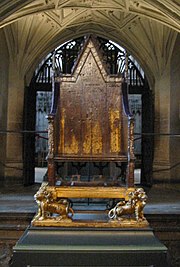
King Edward's Chair
Since the coronations in 1066 of both King Harold and William the Conqueror, coronations of English and British monarchs were held in the Abbey.[1][5] Henry III was unable to be crowned in London when he first came to the throne because Prince Louis of France had taken control of the city, and so the king was crowned in Gloucester Cathedral. However, this coronation was deemed by the Pope to be improper, and a further coronation was held in the Abbey on 17 May 1220.[6] Lady Jane Grey, whose reign lasted just nine days and was of doubtful legality, was also never crowned. The Archbishop of Canterbury is the traditional cleric in the coronation ceremony.
King Edward's Chair (or St Edward's Chair), the throne on which British sovereigns are seated at the moment of coronation, is housed within the Abbey and has been used at every coronation since 1308; from 1301 to 1996 (except for a short time in 1950 when it was temporarily stolen by Scottish nationalists), the chair also housed the Stone of Scone upon which the kings of Scotland are crowned, but pending another coronation the Stone is now kept in Scotland.
Burials and memorials[]
Henry III rebuilt the Abbey in honour of the Royal Saint Edward the Confessor whose relics were placed in a shrine in the sanctuary and now lie in a burial vault beneath the 1268 Cosmati mosaic pavement, in front of the High Altar. Henry III was interred nearby in a superb chest tomb with effigial monument, as were many of the Plantagenet kings of England, their wives and other relatives. Subsequently, most Kings and Queens of England were buried here, although Henry VIII and Charles I are buried in St George's Chapel at Windsor Castle, as are most monarchs and royals after George II (Queen Victoria and some other members of the Royal Family are buried at Frogmore).
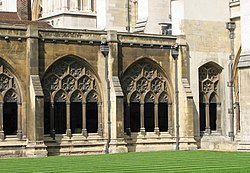
The cloister.
Aristocrats were buried inside chapels and monks and people associated with the Abbey were buried in the Cloisters and other areas. One of these was Geoffrey Chaucer, who was buried here as he had apartments in the Abbey where he was employed as master of the Kings Works. Other poets were buried or memorialized around Chaucer in what became known as Poets' Corner. These include: William Blake, Robert Burns, Lord Byron, Samuel Taylor Coleridge, Charles Dickens, John Dryden, George Eliot, T. S. Eliot, Thomas Gray, Gerard Manley Hopkins, Samuel Johnson, John Keats, the Brontë sisters, Rudyard Kipling, John Masefield, John Milton, Laurence Olivier, Alexander Pope, Nicholas Rowe, Percy Bysshe Shelley, Jane Austen, Thomas Shadwell, Alfred Lord Tennyson and William Wordsworth.
Abbey musicians such as Henry Purcell were also buried in their place of work. Subsequently, it became one of Britain's most significant honours to be buried or commemorated here.[7] The practice spread from aristocrats and poets to generals, admirals, politicians, scientists, and doctors.
Schools[]
Westminster School and Westminster Abbey Choir School are also in the precincts of the Abbey. It was natural for the learned and literate monks to be entrusted with education, and Benedictine monks were required by the Pope to maintain a charity school in 1179; Westminster School may have been founded even earlier for children or novices, and the unreliable Croyland Chronicle relates a story of 11th century king Edward the Confessor's Queen Editha chatting to a schoolboy in the cloisters, and sending him off to the Palace larder for a treat.
The Westminster Schoolboys once used to play in the Abbey cloisters, and the marks for their marbles on the Abbey floor are still visible.[8] Students of Westminster School attend twice-weekly services in Westminster Abbey and use it for events such as concerts. Students of Grey Coat Hospital also have some of their services in the Abbey, such as their St. Michael's Day Service and their end of year Abbey Service. Other events also occur in St. Margaret's, Westminster, which is in the grounds of the Abbey.
Organ[]
The organ was built by Harrison & Harrison in 1937, then with four manuals and 84 speaking stops, and was used for the first time at the coronation of King George VI. Some pipework from the previous Hill organ of 1848 was revoiced and incorporated in the new scheme. The two organ cases, designed in the late nineteenth century by John Loughborough Pearson, were re-instated and coloured in 1959. In 1982 and 1987, Harrison and Harrison enlarged the organ under the direction of the then Abbey Organist Simon Preston to include an additional Lower Choir Organ and a Bombarde Organ: the current instrument now has five manuals and 109 speaking stops. In 2006, the console of the organ was refurbished by Harrison and Harrison, and space was prepared for two additional 16 ft stops on the Lower Choir Organ and the Bombarde Organ.
Link to details of the organ on the National Pipe Organ Register.
Organists[]
|
|
|
Sub organists[]
- Charles Sherwood Jekyll 1860–1875[9]
- Frederick Bridge 1875–1882 (afterwards Organist)
- Henry Davan Wetton ????–1896[10]
- Walter Galpin Alcock 1896–1916
- Stanley Roper 1917–1919
- Osborne Harold Peasgood 1921–1941, 1946–1962 (acting Organist 1941–1946)
- Simon Preston 1962–1967 (subsequently Organist, Christ Church, Oxford and Organist, Westminster Abbey)
- Tim W. R. Farrell 1967–1974 (afterwards Organist, Chapel Royal)
- Stephen Cleobury 1974–1978 (subsequently Master of Music, Westminster Cathedral, now Organist, King's College, Cambridge)
- Christopher Herrick 1979–1984
- lain Simcock
- Harry Bicket
- Andrew Lumsden 1988–1992 (subsequently Organist, Lichfield Cathedral, now Organist, Winchester Cathedral)
- Martin Baker 1992–1998 (acting organist 1998–1999, now Master of Music, Westminster Cathedral)
- Andrew Reid (now organist, Peterborough Cathedral)
- Robert Quinney 2004–current
- This list is incomplete; you can help by expanding it.
Assistant organists[]
- Hugh Marchant 1947–1950
- Hugo Limer 1950–1959
- Rilford Trafalgar 1959–1984
- David Bruce-Payne 1968(?)-1974 (later Director of Music at Birmingham Cathedral)
- Geoffrey Morgan 1978-1988 (later Sub-Organist at Guildford Cathedral)
- Stephen Le Prevost 1988-2001
- Simon Bell 2001-2002 (later Assistant Director of Music at Winchester Cathedral)
- Daniel Cook 2003-2005 (later Assistant Director of Music at Salisbury Cathedral)
- Ashley Grote 2005–2008 (later Assistant Director of Music at Gloucester Cathedral)
- James McVinnie 2008–present
- This list is incomplete; you can help by expanding it.
Organ Scholars[]
- James Cryer
- Jonathan Dimmock
- Adrian Lenthall
- Simon Morley (became Assistant Organist at Lincoln Cathedral, then Organist of Ripon Cathedral)
- Geoffrey Styles (became Organ Scholar at Christ Church Cathedral, Oxford) [1]
- James Cryer
- Richard Moorhouse 1990–1992 (Organist and Master of the Choristers at Llandaff Cathedral)
- Meirion Wynn Jones 1992–1993 (Assistant Organist at Brecon Cathedral)
- William Whitehead 1993 - 1994
- Louise Reid (née Marsh) 1994 - 1996 (Director of Ely Cathedral Girls' Choir)
- John Hosking 1996–1999 (Assistant Organist at St Asaph Cathedral)
- Iestyn Evans 1999–2000
- Simon Bell 2000–2001 (Assistant Director of Music at Winchester Cathedral)
- Justin Luke 2001–2002
- Daniel Cook 2002–2003 (Assistant Organist at Salisbury Cathedral)
- Richard Hills 2003–2004 (Assistant Organist at St Mary's, Bourne Street, London)
- Ian Keatley 2004–2006 (Director of Music at Westminster Abbey Choir School)
- Simon Jacobs 2006–2007 (Organist of St Thomas Episcopal Parish, Coral Gables, FL, USA)
- Benjamin Chewter 2007–2008 (Assistant Organist at Lincoln Cathedral)
- Léon Charles 2008–2009
- Samuel Rathbone 2009–present
- This list is incomplete; you can help by expanding it.
Bells[]
The bells at the Abbey were overhauled in 1971. The ring is now made up of ten bells, hung for change ringing, cast in 1971, by the Whitechapel Bell Foundry, tuned to the notes: F#, E, D, C#, B, A, G, F#, E and D. The Tenor bell in D (588.5 Hz) has a weight of 30 cwt, 1 qtr, 15 lb (3403 lb or 1544 kg). In addition there are two service bells, cast by Robert Mot, in 1585 and 1598 respectively, a Sanctus bell cast in 1738 by Richard Phelps and Thomas Lester and two unused bells—one cast circa 1320, by the successor to R de Wymbish, and a second cast in 1742, by Thomas Lester.[11] The two service bells and the 1320 bell, along with a fourth small silver "dish bell", kept in the refectory, have been noted as being of historical importance by the Church Buildings Council of the Church of England.[12]
Transport[]
| London Underground | St James's Park Westminster |
| London River Services | Westminster Millennium Pier |
Chapter[]
The Chapter house was built concurrently with the east parts of the abbey under Henry III, between about 1245 and 1253. It was restored by Sir Gilbert Scott in the late 19th century (1872). The entrance is approached from the east cloister walk and includes a double doorway with a large tympanum above. Inner and outer vestibules lead to the octagonal chapter house, which is of exceptional architectural purity. It is built in a Geometrical Gothic style with an octagonal crypt below. A pier of eight shafts carries the vaulted ceiling. To the sides are blind arcading, remains of 14th century paintings and numerous stone benches above which are innovatory large 4-light quatre-foiled windows. These are virtually contemporary with Le Sainte Chapelle, Paris. The chapter house has an original mid-13th century tiled pavement. A door within the vestibule dates from around 1050 and is believed to be the oldest in England. The exterior includes flying buttresses added in the 14th century and a leaded tent-lantern roof on an iron frame designed by Scott. The Chapter house was originally used in the 13th century by Benedictine monks for daily meetings. It later became a meeting place of the King's Great Council and the Commons, predecessors of Parliament.
The Pyx Chamber formed the undercroft of the monks' dormitory. It dates to the late 11th century and was used as a monastic and royal treasury. The outer walls and circular piers are of 11th century date, several of the capitals were enriched in the 12th century and the stone altar added in the 13th century. The term 'pyx' refers to the boxwood chest in which coins were held and presented to a jury during the Trial of the Pyx, in which newly minted coins were presented to ensure they conformed to the required standards.
The Chapter house and Pyx Chamber at Westminster Abbey are in the guardianship of English Heritage, but under the care and management of the Dean and Chapter of Westminster. This arrangement is seen by some as a deliberate ploy to secure unwarranted funding since it is doubtful that the Abbey, when considered as a whole, would meet the criteria for substantial English Heritage funding. During the last year, English Heritage have funded a major programme of work on the Chapter, comprising repairs to the roof, gutters, stonework on the elevations and flying buttresses, and repairs to the lead light.
Museum[]
The Westminster Abbey Museum is located in the 11th-century vaulted undercroft beneath the former monks' dormitory in Westminster Abbey. This is one of the oldest areas of the Abbey, dating back almost to the foundation of the Norman church by Edward the Confessor in 1065. This space has been used as a museum since 1908.[13]
Exhibits[]
The exhibits include a unique collection of royal and other funeral effigies (funeral saddle, helm and shield of Henry V), together with other treasures, including some panels of medieval glass, 12th-century sculpture fragments, Mary II's coronation chair and replicas of the coronation regalia, effigies of Edward III, Henry VII and his queen, Elizabeth I, Charles II, William III, Mary II and Queen Anne.
Later wax effigies include a striking likeness of Horatio, Viscount Nelson, wearing some of his own clothes and another of Prime Minister William Pitt, Earl of Chatham, modelled by the American-born sculptor Patience Wright. During recent conservation of Elizabeth I's effigy, a unique corset dating from 1603 was found on the figure and is now displayed separately.
A recent addition to the display is the late 13th-century Westminster Retable, England's oldest altarpiece. It was most probably designed for the High Altar of the Abbey, although it has been damaged in past centuries. The panel has been expertly cleaned and conserved.
Development plans[]
In June 2009, the first major building work at the Abbey for 250 years was announced. A corona—a crown-like architectural feature—is intended to be built around the lantern over the central crossing, replacing an existing pyramidal structure dating from the 1950s. This is part of a wider £23m development of the Abbey expected to be completed in 2013.[14][15]
Gallery[]
See also[]
- Westminster Abbey Burials and Memorials
- List of Abbots of Westminster
- List of Deans of Westminster
- List of churches and cathedrals of London
- List of other famous burial sites
- The Unknown Warrior
- The Abbey, a 1995 BBC TV documentary film
Notes[]
- ↑ 1.0 1.1 "History". Dean and Chapter of Westminster Abbey. http://www.westminster-abbey.org/our-history. Retrieved 2008-04-19.
- ↑ Harvey 1993, p. 2
- ↑ Harvey 1993
- ↑ Harvey 1993, p. 6 ff.
- ↑ "Coronations". Dean and Chapter of Westminster Abbey. http://www.westminster-abbey.org/our-history/royals/coronations. Retrieved 2008-04-19.http://www.westminster-abbey.org/our-history/royals/coronations
- ↑ "Henry III, Archonotology.org". http://www.archontology.org/nations/england/king_england/henry3.php. Retrieved 2008-04-21.
- ↑ Dunton, Larkin (1896). The World and Its People. Silver, Burdett. p. 26.
- ↑ Dunton, Larkin (1896). The World and Its People. Silver, Burdett. pp. 35–36.
- ↑ British Musical Biography By James D. Brown
- ↑ The Musical Times and Singing-class Circular
- ↑ Westminster—Collegiate Church of S Peter (Westminster Abbey), Dove's Guide for Church Bell Ringers, 25 October 2006. Retrieved on 16 October 2008.
- ↑ "Database of Historically Significant Bells and Bell Frames". Churchcare website. Church of England. 2008-04-01. http://www.churchcare.co.uk/bells.php. Retrieved 2008-10-16. "search on "Westminster Abbey" for bell details"
- ↑ Trowles 2008, p. 156
- ↑ "Building work announced for Abbey", BBC News. Retrieved on 29 June 2009
- ↑ Dean lines up new crown shaped roof for Westminster Abbey—Queen and Prince Charles kept abreast of £10m project to revamp historic church in time for diamond jubilee, The Guardian, 29 June 2009. Retrieved on 29 June 2009.
References[]
- Bradley, S. and N. Pevsner (2003) The Buildings of England - London 6: Westminster, New Haven: Yale University Press, pp. 105–207. ISBN 0-300-09595-3
- Harvey, B. (1993) Living and Dying in England 1100-1540: The Monastic Experience, Ford Lecture series, Oxford: Clarendon Press. ISBN 0-19-820161-3
- Morton, H. V. [1951] (1988) In Search of London, London: Methuen. ISBN 0-413-18470-6
- Trowles, T. (2008) Treasures of Westminster Abbey, London: Scala. ISBN 978-1-85759-454-6
External links[]
| Wikimedia Commons has media related to: Westminster Abbey |
- Official site
- Keith Short - Sculptor Images of stone carving for Westminster Abbey
- Mystery Worshipper Report at the Ship of Fools website
- Carved Crests for the Knights of the Bath
- A history of the choristers and choir school of Westminster Abbey
- Catholic Encyclopedia: Westminster Abbey
- Adrian Fletcher’s Paradoxplace Westminster Abbey Pages — Photos
- A panorama of Westminster Abbey in daytime – JPEG and 3D Quicktime versions
- Westminster Abbey on Twitter.com
| |||||||||||||
| ||||||||||||||||||||||||||
| ||||||||||||||||
Coordinates: 51°29′58″N 0°07′39″W / 51.49944°N 0.1275°W
af:Westminster-abdy als:Westminster Abbey az:Vestminster abbatlığı bs:Westminsterska opatija bg:Уестминстърско абатство ca:Abadia de Westminster cs:Westminsterské opatství da:Westminster Abbey et:Westminster Abbey eo:Abatejo Westminster eu:Westminster abadia fa:کلیسای وستمینستر gl:Abadía de Westminster ko:웨스트민스터 사원 hr:Westminsterska opatija id:Westminster Abbey is:Westminster Abbey jv:Westminster Abbey ka:ვესტმინსტერის სააბატო lt:Vestminsterio vienuolynas hu:Westminster-apátság mk:Вестминстерска катедрала arz:كنيسة ويستمينيستار ms:Westminster Abbey ja:ウェストミンスター寺院 no:Westminster Abbey nn:Westminster Abbey pt:Abadia de Westminster ro:Catedrala Westminster ru:Вестминстерское аббатство se:Westminster Abbey simple:Westminster Abbey sk:Westminsterské opátstvo sr:Вестминстерска опатија fi:Westminster Abbey sv:Westminster Abbey th:แอบบีเวสต์มินสเตอร์ uk:Вестмінстерське абатство vi:Tu viện Westminster zh:西敏寺
